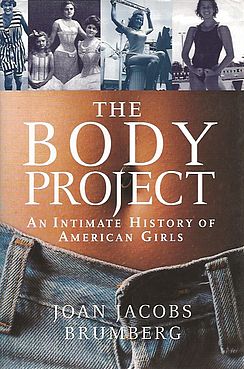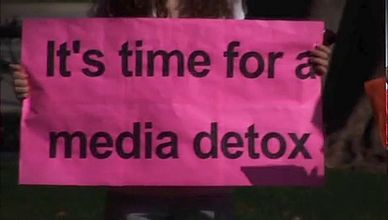Click! in the Classroom
The Body Project: Media’s Influence
Grade Level: Grades 6-12 | Estimated Time: One class period |
Introduction
Women’s history and gender analysis can empower students in a world where media messages are overtly and covertly directed at young people. Women’s history provides students with an understanding that ideas—about bodies and minds—have changed over time. Gender analysis, along with racial and class analysis, encourages deeper understandings of the role of advertisements in our culture today. This lesson teaches media literacy to empower young people to think about their relationships to movies and television shows, print and online advertisements, and social media.
According to media scholar Jean Kilbourne, the advertising industry affects everyone but adolescents are most susceptible to the stereotypes that pervade advertisements and have the most difficulty questioning the cultural messages spread through media. Today, the global advertising industry spends about $500 billion dollars, with about $200 billion dollars spent on digital advertising. Most Americans see 4,000 to 10,000 advertisements a day. These advertisements mingle with the images that young people share on social media and research shows that young women who post images of themselves compare their bodies to the digital images posted by or of other women, including celebrities. Not surprisingly, they think they are less attractive than the celebrities. Learning about the power of advertising in a social-media world can help young people untangle the stereotypes and counter the harmful comparisons.
Warning: This can be a sensitive topic for some individuals. Let students know upfront what you will be discussing in class and give them the opportunity to voice questions and concerns they may have in regards to the topic.
Learning Objectives
The aim is to open conversations and explorations with students about the media and its connection to messages that are conveyed about women’s bodies.
Students will be able to demonstrate an emerging understanding of media literacy.
Students will be able to discuss and justify their opinions about media messages.
Essential Questions
How does advertising convey messages about bodies?
Does advertising target girls and boys, women and men, in similar or different ways?
How do societal expectations about beauty and health influence our actions and interactions?
Materials
Computer with Speakers and Internet Access
This Lesson Plan (PDF)
Key Words Organizer (PDF)
KWL Chart (PDF)
Who defines what is beautiful? What is the media’s role?
Excerpt from “Cover Girl Culture: Awakening the Media Generation,” a film by Nicole Clark. (Running time 12:16) Used with permission. The complete film is available from Zen Pen Films. More resources are available in Nicole Clark's Clever Girl Workshops.
Warm Up Activity: Film Viewing and Discussion
Hand out a KWL Chart to each student.
Have them fill in the “What I Know” section by addressing the question: “What do you know about advertisements, and specifically how women’s and men’s bodies are portrayed in advertisements?”
Tell them they will see a short clip to give them more information about media’s influence on how we think about our bodies.
Show a clip from the film Cover Girl Culture: Awakening the Media Generation (12:15 min.), also located above.
After viewing the film, have the students fill in the “What I Want to Know” section of the
KWL Chart.Open up class discussion by asking the students if the writers and editors who were interviewed in the film introduced them to new ideas or information.
Ask them if they agreed with or disagreed with any of the comments by the students who were interviewed.
Transition to the Main Activity by explaining to the students that they are going to be learning more about media’s influence by reading a chapter from Click, identifying its key words, and summarizing its contents.
Main Activity: Key Word Analysis and Discussion
Divide the class into groups. Hand out a Key Words Organizer to each student.
Have students go to Click section “Women’s Bodies” in the Body & Health chapter. (Note: The second paragraph begins: “If we are going to talk about women’s bodies, maybe we need to define our terms.”)
Tell students to focus on key words in the text.
Have the students list three key words in this reading.
Have them answer the guiding questions under each key word.
What do you think this word means?
When have you heard this word before?
Why did you choose this word?
Have the students fill in the “What I Have Learned” section of their KWL Chart.
Have the students revisit the “What I Want to Know” section of their KWL Chart.
Have them add to this section.
Bring the students back together and have them share their Key Word lists and KWL Charts.
Return to the discussion about advertising and media messages by asking students:
How did viewing the film and reading the chapter section change the way you see advertisements?
Do you think that boys and girls, men and women, share similar issues around the subject of advertising? Why?
Extension Activity: Advertising Analysis
Have the students collect and compare advertisements directed at girls and boys of different ages.
Students can prompt each other about each advertisement by answering the questions on the Advertising Analysis Worksheet.
Class discussion can center on how age and gender influence messages contained in advertisements.
Have students rewrite advertisements to correct the relationship between health and weight. Discuss the choices made for rewriting the advertisement.
Common Core Anchor Standards
Reading
Range of Reading and Level of Text Complexity:
CCSS.ELA-LITERACY.CCRA.R.10
Read and comprehend complex literary and informational texts independently and proficiently.
Speaking and Listening
Comprehension and Collaboration:
CCSS.ELA-LITERACY.CCRA.SL.2
Integrate and evaluate information presented in diverse media and formats, including visually, quantitatively, and orally.
Language
Vocabulary Acquisition and Use:
CCSS.ELA-LITERACY.CCRA.L.6
Acquire and use accurately a range of general academic and domain-specific words and phrases sufficient for reading, writing, speaking, and listening at the college and career readiness level; demonstrate independence in gathering vocabulary knowledge when encountering an unknown term important to comprehension or expression.
How to Navigate our Interactive Timeline
You will find unique content in each chapter’s timeline.
Place the cursor over the timeline to scroll up and down within the timeline itself. If you place the cursor anywhere else on the page, you can scroll up and down in the whole page – but the timeline won’t scroll.
To see what’s in the timeline beyond the top or bottom of the window, use the white “dragger” located on the right edge of the timeline. (It looks like a small white disk with an up-arrow and a down-arrow attached to it.) If you click on the dragger, you can move the whole timeline up or down, so you can see more of it. If the dragger won’t move any further, then you’ve reached one end of the timeline.
Click on one of the timeline entries and it will display a short description of the subject. It may also include an image, a video, or a link to more information within our website or on another website.
Our timelines are also available in our Resource Library in non-interactive format.
Timeline Legend
Yellow bars mark entries that appear in every chapter
This icon indicates a book
This icon indicates a film
1971 The Click! Moment
The idea of the “Click! moment” was coined by Jane O’Reilly. “The women in the group looked at her, looked at each other, and ... click! A moment of truth. The shock of recognition. Instant sisterhood... Those clicks are coming faster and faster. They were nearly audible last summer, which was a very angry summer for American women. Not redneck-angry from screaming because we are so frustrated and unfulfilled-angry, but clicking-things-into-place-angry, because we have suddenly and shockingly perceived the basic disorder in what has been believed to be the natural order of things.” Article, “The Housewife's Moment of Truth,” published in the first issue of Ms. Magazine and in New York Magazine. Republished in The Girl I Left Behind, by Jane O'Reilly (Macmillan, 1980). Jane O'Reilly papers, Schlesinger Library.



